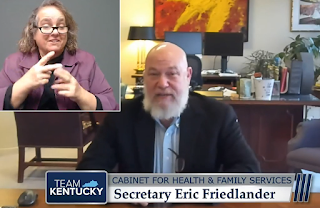
Friedlander and interpreter Virginia Moore announced the new hospital payment program.
—–
By Melissa Patrick
Kentucky Health News
With up to 28 rural Kentucky hospitals vulnerable to closure if their financial situation does not improve, the announcement of a new payment model to increase the amount Kentucky’s hospitals are paid for Medicaid patients is cause for their celebration.
“Improved reimbursement for Kentucky’s hospitals is vital for their survival. Medicaid . . . does not cover the full cost of caring for the patients we serve,” Nancy Galvagni, president of the Kentucky Hospital Association, said at Gov. Andy Beshear’s news briefing Tuesday. “Every year our state’s hospitals see a shortfall from treating Medicaid patients. And with more than a third of the state’s population covered by Medicaid, this is an unsustainable model.”
Galvagni later told Kentucky Health News that the risk of closure is real for many Kentucky hospitals, noting that just last year Our Lady of Bellefonte Hospital in Ashland and that Jewish Hospital in Louisville likely would have closed if it had not been taken over by the University of Louisville.
“When you are operating with a majority of your patients who are being paid below cost, they can’t reinvest in the facility or the capital requirements,” she said.
Health Secretary Eric Friedlander told Kentucky Health News that the new model will allow the state’s hospitals to get paid an “average commercial rate,” which is what private insurers would pay for health care in hospitals, instead of the current Medicaid rate, which he said is “way below that amount.”
Gov. Andy Beshear said at the briefing that this new Medicaid payment model will result in an additional $800 million to $1 billion annually.
In order to receive these funds, hospitals will have to abide by higher quality standards that are still being decided upon by KHA and the Cabinet for Health and Family Services. Quality standards include things like hospital-acquired infections, medication errors or readmission rates.
Friedlander called the payment model a “creative response” to what is allowed by the Centers for Medicare and Medicaid Services. He said the University of Kentucky and University of Louisville hospitals already have a similar mode of payment.
The next step is for the General Assembly to approve the appropriation via House Bill 183, sponsored by Rep. Brandon Reed, R-Hodgenville. It would give the cabinet the authority to spend the money, which will be provided by the hospital association. It also allows for increased flexibility by allowing the state to exempt hospitals that would not benefit from the program.
Friedlander explained that this new program does not incur any additional cost to the state because Kentucky’s hospitals have agreed to cover it.
Further, he said a move to this new payment model will result in more money for the state. Beshear’s news release says the Department for Medicaid Services will have access to an additional $50 million to $80 million in funding.
Calling it a “fantastic win” for everyone, Galvagni said, “This could mean the difference between keeping the lights on and closing the doors to many of our hospitals across the state.”
Friedlander added that this increased funding is important for a myriad of reasons. “This is designed to improve quality,” he said. “It is designed to improve reimbursement to hospitals so that they’re not taking the losses on their Medicaid patients. This will be designed to support financially, keeping all the hospitals in Kentucky open so we won’t see more closures. This will go to improve infrastructure. And this ends up not being a cost to the state.”
Further, he said it will decrease uncompensated care at hospitals and will serve as an incentive to get everyone who is eligible signed up for Medicaid, “because the difference between a Medicaid patient now and somebody who is not insured is immense.”
Carl Herde, vice-president of financial policy at the KHA, in a phone interview spoke to the importance of keeping hospitals open, not only because of the jobs they bring to a community, but also because studies show that communities without hospitals have higher mortality rates.
“When we get House Bill 183 passed and we move this forward, I think this really does create a path for financial stability, for specifically the small rural hospitals,” he said, adding that most of the most financially vulnerable hospitals in the state are the small, rural ones. “And so we do think this creates a sustainable path for financial viability into the future for those communities.”
The state plan amendment for these changes was filed Sept. 30, which means the federal government will allow the state to back-pay hospitals at the new rate starting July 1.
Friedlander added that this new model, which must be approved annually, will help most of the state’s hospitals and that the state and KHA has committed to making sure it does not harm any of them.
Friedlander and KHA said they were unsure, but thinks Kentucky is the first state to implement this particular payment model statewide. KHA added that other states have Medicaid payment programs that are funded at this level, but are done differently.
